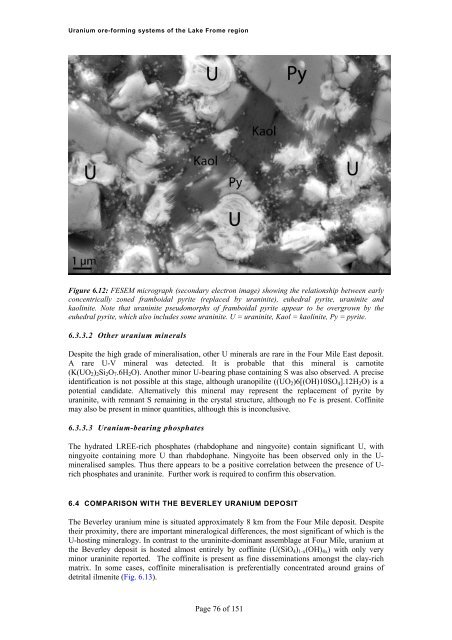Uranium ore-forming systems of the - Geoscience Australia
Uranium ore-forming systems of the - Geoscience Australia
Uranium ore-forming systems of the - Geoscience Australia
You also want an ePaper? Increase the reach of your titles
YUMPU automatically turns print PDFs into web optimized ePapers that Google loves.
<strong>Uranium</strong> <strong>ore</strong>-<strong>forming</strong> <strong>systems</strong> <strong>of</strong> <strong>the</strong> Lake Frome regionFigure 6.12: FESEM micrograph (secondary electron image) showing <strong>the</strong> relationship between earlyconcentrically zoned framboidal pyrite (replaced by uraninite), euhedral pyrite, uraninite andkaolinite. Note that uraninite pseudomorphs <strong>of</strong> framboidal pyrite appear to be overgrown by <strong>the</strong>euhedral pyrite, which also includes some uraninite. U = uraninite, Kaol = kaolinite, Py = pyrite.6.3.3.2 O<strong>the</strong>r uranium mineralsDespite <strong>the</strong> high grade <strong>of</strong> mineralisation, o<strong>the</strong>r U minerals are rare in <strong>the</strong> Four Mile East deposit.A rare U-V mineral was detected. It is probable that this mineral is carnotite(K(UO 2 ) 2 Si 2 O 7 .6H 2 O). Ano<strong>the</strong>r minor U-bearing phase containing S was also observed. A preciseidentification is not possible at this stage, although uranopilite ((UO 2 )6[(OH)10SO 4 ].12H 2 O) is apotential candidate. Alternatively this mineral may represent <strong>the</strong> replacement <strong>of</strong> pyrite byuraninite, with remnant S remaining in <strong>the</strong> crystal structure, although no Fe is present. C<strong>of</strong>finitemay also be present in minor quantities, although this is inconclusive.6.3.3.3 <strong>Uranium</strong>-bearing phosphatesThe hydrated LREE-rich phosphates (rhabdophane and ningyoite) contain significant U, withningyoite containing m<strong>ore</strong> U than rhabdophane. Ningyoite has been observed only in <strong>the</strong> U-mineralised samples. Thus <strong>the</strong>re appears to be a positive correlation between <strong>the</strong> presence <strong>of</strong> U-rich phosphates and uraninite. Fur<strong>the</strong>r work is required to confirm this observation.6.4 COMPARISON WITH THE BEVERLEY URANIUM DEPOSITThe Beverley uranium mine is situated approximately 8 km from <strong>the</strong> Four Mile deposit. Despite<strong>the</strong>ir proximity, <strong>the</strong>re are important mineralogical differences, <strong>the</strong> most significant <strong>of</strong> which is <strong>the</strong>U-hosting mineralogy. In contrast to <strong>the</strong> uraninite-dominant assemblage at Four Mile, uranium at<strong>the</strong> Beverley deposit is hosted almost entirely by c<strong>of</strong>finite (U(SiO 4 ) 1-x (OH) 4x ) with only veryminor uraninite reported. The c<strong>of</strong>finite is present as fine disseminations amongst <strong>the</strong> clay-richmatrix. In some cases, c<strong>of</strong>finite mineralisation is preferentially concentrated around grains <strong>of</strong>detrital ilmenite (Fig. 6.13).Page 76 <strong>of</strong> 151
















